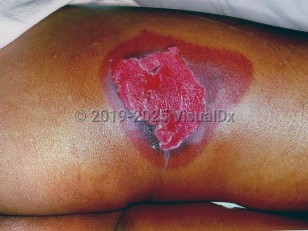Patients are most likely to be exposed from transportation incidents, nuclear reactor incidents, radiation exposure devices (REDs), radiological dispersal devices (RDDs, dirty bomb), or an improved nuclear explosive device. The radiation dose is large, external (except with shrapnel or inhaled material), and from penetrating radiation such as high-energy x-rays, gamma rays, and neutrons.
The amount of radiation exposure is typically discussed using the International System of Units (SI) unit Gray (Gy) or radiation absorbed dose (rad), where 1 Gy equals 100 rad.
Rapid onset of severe central nervous system (CNS) symptoms including early nausea, vomiting, and altered mental status (not explained by traumatic brain injury), as well as hemodynamic instability (not explained by traumatic injuries), suggests very high radiation exposure.
ARS has 4 classic syndromes. Some of these syndromes may take days to appear. Very high initial doses may produce the rapid onset of severe cerebral edema and death within 72 hours of exposure.
- Bone marrow syndrome: bone marrow syndrome (hematopoietic syndrome) typically occurs from radiation doses greater than 0.7 Gy (70 rad). The survival rate decreases with increased doses. Principal cause of death is from acute bone marrow suppression leading to immunocompromised state with resultant infection or from hemorrhage. Leukopenia and thrombocytopenia are hallmarks.
- Gastrointestinal syndrome: gastrointestinal (GI) syndrome is usually from radiation doses greater than 10 Gy (1000 rad). Survival is unlikely, as there is widespread irreparable destruction of GI tissues and bone marrow. Symptoms: nausea, vomiting, diarrhea, GI hemorrhage, dehydration, and electrolyte imbalance resulting in septicemia and death.
- Cardiovascular and CNS syndrome: cardiovascular (CV) and CNS syndrome is the result of radiation exposures greater than 50 Gy (5000 rad). Tissue destruction resulting in cerebral edema, vasculitis, and meningitis along with cardiac dysfunction and cardiovascular collapse are seen. Death typically occurs within 3 days.
- Cutaneous radiation syndrome: cutaneous radiation syndrome is described in patients with acute radiation exposure to skin. This is the result of direct contact with radioactive materials or from beta radiation (high-energy electrons) or x-rays.
When victims of improvised explosive devices are transported to your facility, the possibility that the event is an RDD must be considered. For RDDs, management of life-threatening traumatic injuries must occur in concert with site and health care worker protection.
Health care workers without specific radiation exposure should work in concert with radiation experts to implement measures to minimize hospital contamination and health care worker exposure. Considerations for decontamination, personal protective equipment, management of suspected contaminated wounds, internal contamination, dose estimation, and early countermeasure administration will require multiprofessional and multidisciplinary consultation. The basis to minimize exposure is timing, shielding, and distance from the source.



